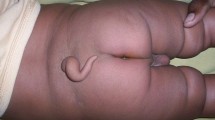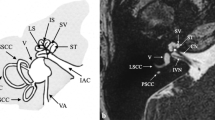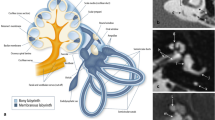Abstract
Introduction
Hypoplastic cochleae are among the inner ear malformations more frequently encountered by radiologists; little detailed information is available on these, however. We present the first large series of hypoplastic cochleae and document imaging findings to better characterize this anomaly radiologically.
Methods
We used our electronic database to search for inner ear malformations described between 1995 and 2009 and extracted 81 ears (of 47 patients) with hypoplastic cochleae out of 289 patients with inner ear malformations. Two neuroradiologists evaluated the available CT and MRI data. Measurements of all inner ear structures were performed. Accompanying findings were listed.
Results
Cochlear hypoplasia (58 ears, 32 patients) often involves not only the apical turn being reduced in size but also the basal turn being smaller in length. Additionally, 11 ears (eight patients) of hypoplastic cochleae with only a basal turn and five ears (four patients) of cochleae with only a small bud were identified. Non-classifiable hypoplastic cochleae (seven ears, five patients) were those with either a rudimentary or an absent basal turn or a “dwarf appearance” with no further partition.
Conclusions
The term “hypoplastic cochlea” is very general; a further division into severe and less severe forms based on the length and existence of cochlea turns is possible and can help enhance the comparison of CI outcome data. Measurements can help the less experienced radiologist to detect them more easily.






Similar content being viewed by others
References
Lo WW (1999) What is a ‘Mondini’ and what difference does a name make? AJNR Am J Neuroradiol 20:1442–1444
Sennaroglu L, Saatci I (2002) A new classification for cochleovestibular malformations. Laryngoscope 112:2230–2241
Mondini C (1997) Minor works of Carlo Mondini: the anatomical section of a boy born deaf. Am J Otol 18:288–293
Jackler RK, Luxford WM, House WF (1987) Congenital malformations of the inner ear: a classification based on embryogenesis. Laryngoscope 97:2–14
Purcell D, Johnson J, Fischbein N et al (2003) Establishment of normative cochlear and vestibular measurements to aid in the diagnosis of inner ear malformations. Otolaryngol Head Neck Surg 128:78–87
Krombach GA, van den Boom M, Di Martino E et al (2005) Computed tomography of the inner ear: size of anatomical structures in the normal temporal bone and in the temporal bone of patients with Meniere’s disease. Eur Radiol 15:1505–1513
Romo LVC, JW RCD (2003) Temporal bone: congenital anomalies. In: Som P, Curtin H (eds) Head and neck imaging. Mosby, St Louis, pp 1109–1171
Schuknecht HF (1993) Pathology of the ear. Lea & Febiger, Malvern
Casselman JW, Offeciers FE, Govaerts PJ et al (1997) Aplasia and hypoplasia of the vestibulocochlear nerve: diagnosis with MR imaging. Radiology 202:773–781
Shim HJ, Shin JE, Chung JW et al (2006) Inner ear anomalies in cochlear implantees: importance of radiologic measurements in the classification. Otol Neurotol 27:831–837
Streeter GL (1948) Developmental horizons in human embryos. Description of age groups XV, XVI, XVII, and XVIII, being the third issue of a survey of the Carnegie Collection. Contrib Embryol 32:133–203
Papsin BC (2005) Cochlear implantation in children with anomalous cochleovestibular anatomy. Laryngoscope 115:1–26
Park AH, Kou B, Hotaling A et al (2000) Clinical course of pediatric congenital inner ear malformations. Laryngoscope 110:1715–1719
Ma H, Han P, Liang B et al (2008) Multislice spiral computed tomography imaging in congenital inner ear malformations. J Comput Assist Tomogr 32:146–150
Koch BL (2007) Labyrinthine aplasia. In: Barkovitch AJ (ed) Diagnostic imaging pediatric neuroradiology. Amirsys, Salt Lake City, pp II1-2–II1-3
Hudgins PA (2004) Labyrinthine aplasia. In: Harnsberger HR (ed) Diagnostic imaging head and neck. Amirsys, Salt Lake City, pp I2-96–I2-97
Rodriguez K, Shah RK, Kenna M (2007) Anomalies of the middle and inner ear. Otolaryngol Clin North Am 40:81–96, vi
Robson CD, Robertson RL, Barnes PD (1999) Imaging of pediatric temporal bone abnormalities. Neuroimaging Clin N Am 9:133–155
Zheng Y, Schachern PA, Cureoglu S et al (2002) The shortened cochlea: its classification and histopathologic features. Int J Pediatr Otorhinolaryngol 63:29–39
Romo LV, Curtin HD (2001) Anomalous facial nerve canal with cochlear malformations. AJNR Am J Neuroradiol 22:838–844
Davidson HC, Harnsberger HR, Lemmerling MM et al (1999) MR evaluation of vestibulocochlear anomalies associated with large endolymphatic duct and sac. AJNR Am J Neuroradiol 20:1435–1441
Jackler RK, De La Cruz A (1989) The large vestibular aqueduct syndrome. Laryngoscope 99:1238–1242, discussion 1242–1233
Valvassori GE (1983) The large vestibular aqueduct and associated anomalies of the inner ear. Otolaryngol Clin North Am 16:95–101
Koesling S, Rasinski C, Amaya B (2006) Imaging and clinical findings in large endolymphatic duct and sac syndrome. Eur J Radiol 57:54–62
Phelps PD (1990) Mondini and ‘pseudo Mondini’. Clin Otolaryngol Allied Sci 15:99–101
Cock E (1838) A contribution to the pathology of congenital deafness. Guys Hosp Rep 7:289–307
Conflict of interest statement
We declare that we have no conflict of interest.
Author information
Authors and Affiliations
Corresponding author
Rights and permissions
About this article
Cite this article
Giesemann, A.M., Goetz, F., Neuburger, J. et al. Appearance of hypoplastic cochleae in CT and MRI: a new subclassification. Neuroradiology 53, 49–61 (2011). https://doi.org/10.1007/s00234-010-0777-3
Received:
Accepted:
Published:
Issue Date:
DOI: https://doi.org/10.1007/s00234-010-0777-3




